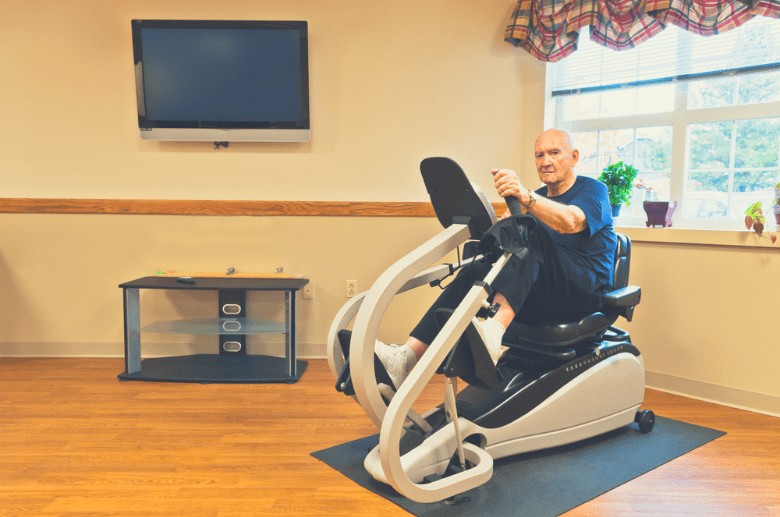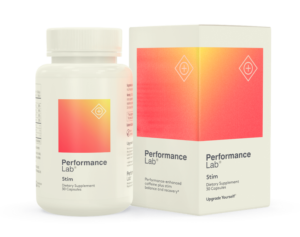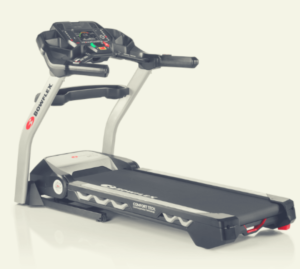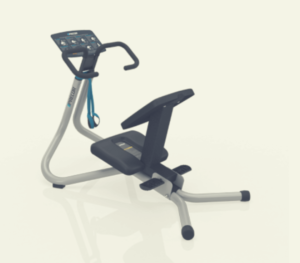Unless you’ve spent some time in physical therapy, it’s possible you’ve never heard of a recumbent cross trainer.
I, myself, had never heard of one until after my brother had knee surgery due to complications from his excessive weight.
If we’d found out about these machines sooner, he might have avoided that surgery altogether.
In this article, we’ll take a look at two popular options – Teeter FreeStep LT3 vs. HCI Fitness Physiotrainer CXT.
What is a Recumbent Cross Trainer?

Recumbent cross trainers are basically crosses between elliptical machines and recumbent bikes.
They’re sometimes referred to as recumbent elliptical trainers or simply recumbent trainers. Still others refer to them simply as “seated elliptical machines.”
Typically, they feature large, super comfy seats much like the kinds of seats found on recumbent bikes, but they should also come with large, elliptical-like pedals as opposed to small, bike-like pedals.
There are handles like those found on an elliptical, which allows you to get a full-body workout as opposed to a simple leg workout.
In short, they’re the best of both worlds.
The machines were originally designed for rehab centers and surgery recovery wards, specifically those where plenty of heart surgeries are done.
They never quite made it into gyms because gyms are generally places where younger, fitter people go to stay healthy, and these machines are specifically designed for older exercisers or exercises recovering from some type of surgery or illness.
The original machines were put out by a company called NuStep, and they’re still hugely popular in these types of places.
Recently, though, the machines have become popular as pieces of in-home gym equipment, particularly for the same demographic as mentioned above (the elderly, those in recovery, etc.).
The problem is that they’re expensive.
When comparing the Teeter FreeStep LT3 vs. HCI Fitness Physiotrainer CXT, both are marketed to individuals rather than hospitals and, as a result, are much more affordable.
While it’s true you still won’t be able to find one for only a couple hundred dollars, there are definitely options that are much more reasonably priced than the original NuStep machines.
First, though, let’s check out some of the things to consider before buying a recumbent cross trainer.
Price
We’ve touched on it already, but price is definitely one of the largest considerations when buying a recumbent cross trainer.
These machines can be incredibly expensive, with some of the highest quality NuStep ones reaching prices well over $7,000.
Getting healthy is important; in fact, keeping yourself healthy and in good physical shape is probably one of the most important things you can do for yourself, but just because you want to be healthier doesn’t mean you magically have thousands of dollars to spend.
The Teeter FreeStep LT3 and the HCI Fitness Physiotrainer CXT aren’t going to cost you that much.
Though prices fluctuate depending on where you buy these machines, you can usually find them for under $1,500.
Many companies/retailers also offer special financing that could help you buy the equipment now and pay for it over time.
The important thing to remember is that there are options out there for these machines that can fit your budget, so don’t do one Google search, find a $6,500 machine and give up hope.
Just keep looking until you find the right machine at the right price.
Resistance Type
There are two main types of resistance with this equipment – air and magnetic. Air resistance uses fan blades to create resistance.
Machines that use this type of resistance usually have a fan as opposed to a flywheel, and resistance is generated by the pressure of the air against the fan’s blades.
The faster and harder you pedal, the more the blades cut through the air, and the more resistance you’ll feel.
More commonly, seated elliptical machines use magnetic resistance.
With this type of resistance, magnets are situated strategically around the flywheel, although they don’t ever actually touch it.
The closer the magnets draw to the flywheel, the more resistance is generated.
The levels are almost always adjustable through a digital control panel or via an adjustable tension knob.
Magnetic resistance is usually much stronger and more precisely controlled than air resistance.
Both the HCI Fitness Physiotrainer CXT and the Teeter FreeStep LT3 use magnetic resistance.
Flywheel
While many people don’t really care about the position of the flywheel, it does matter to some.
The Teeter FreeStep LT3 features a rear flywheel, which is known as “back-drive.” The HCI Fitness Physiotrainer CXT has a flywheel on the front (“front-drive”).
The main difference in the two is that, largely depending on a person’s height/leg length, people using a front-drive machine may have to lean forward in order to really get the machine going properly.
People using back-drive machines don’t have to do this, which makes the movement of the machine feel a little more natural.

Benefits of Using a Recumbent Cross Trainer
There are several benefits to using a recumbent cross trainer. It’s great for burning calories, improving cardiovascular health, and strengthening and toning muscles.
Additionally, these types of machines are especially good for seniors or people in recovery because they allow them to get full-body workouts while sitting.
Not only does this put less strain on their joints, but it also drastically reduces the chance of them losing their balance and/or falling and injuring themselves.
Like normal ellipticals, these machines put very little pressure on the knees, which makes them perfect for people with knee issues, but additionally, they’re also great for people with back problems.
This is especially true if you get one with a high seat back, as that adds extra back support and stability.
The machines also help people improve their balance, mobility and even their posture.
All About the Teeter FreeStep LT3
As long as you don’t mind a little at-home assembly, the Teeter FreeStep LT3 Recumbent Cross Trainer is a great back-drive machine that comes with a lot of great perks and at a reasonable price.
It works well for people of various heights (4’11” to 6’6″) and can hold users up to 300 pounds.
The Teeter FreeStep LT3 uses magnetic resistance and its UltraGlide™ steel ball bearings to ensure a near-silent exercise session, easy startup and frictionless pedaling action.
The amount of magnetic resistance can be adjusted using a dial.
The pedals are large and comfortable, thanks to the “SoftStep” design and rubber overlay, and work in a smooth, gliding elliptical-like motion.
The adjustable seat is also quite plush and enjoyable, and its high back is fantastic for anyone who suffers from lower back pain or back issues of any kind.
The Teeter FreeStep LT3 Recumbent Cross Trainer also utilizes something the company calls “stride technology,” which is equally great for the back.
It allows the machine to follow a natural, linear path that eliminates joint stress and stabilizes the back and hips areas.
The handles are sweat-resistant and glide just as smoothly as the pedals to provide a low-impact, pain-free, total-body workout every time.
The digital tracking system monitors the number of calories burned, the speeds you’re reaching and how long you’ve been exercising, among other things.
Finally, the Teeter FreeStep LT3 comes with two rear wheels that make moving it a snap.
Pros
- Reasonable price with financing available.
- Two-year warranty.
- Large, comfortable pedals.
- High-back, adjustable seat.
- Whisper-quiet exercise experience.
Cons
- Requires some assembly.
- Display is oddly placed and hard to read from a normal seated position.
- Resistance controlled with a dial rather than digitally.
> > Check out our full review of the Teeter Freestep LT3 here < <
All About the HCI Fitness Physiotrainer CXT
The HCI Fitness Physiotrainer CXT costs a bit more than the Teeter LT3, but it also comes fully assembled and ready to use, and to some people, that’s worth the extra money.
Like the Teeter, it’s a high-quality machine that’ll provide people of up to 300 pounds with a low-impact, pain-free, total-body workout, and also like the Teeter, it features a comfortable and adjustable high-backed seat for extra back support and stability.
One of the biggest differences between the two machines is that the HCI features a front-drive flywheel.
Additionally, the HCI Fitness Physiotrainer CXT has pedals that are more like regular, stationary bike pedals. They’re small and have a band to hold your foot in place.
For many people, this is a big downside because they prefer the large, elliptical-like pedals of the Teeter for comfort and ease of use.
Additionally, the movement of the pedals is more like that of a regular bike than an elliptical.
The machine uses magnetic resistance that can be adjusted via a knob on the wheel casing.
Because of the magnetic resistance, the HCI Fitness Physiotrainer CXT is also a very quiet machine.
While the HCI Fitness Physiotrainer CXT has handles that allow for an easy, full-body workout, the machine also comes equipped with multi-level resistance bands, which is a nice feature the Teeter doesn’t have.
These bands are built into the machine, and they add a whole extra level of strength and resistance training to your workout.
The large LCD display on the machine tracks the number of calories burned, your heart rate, speed, time exercising, distance “traveled” and more.
Sadly, the HCI Fitness Physiotrainer CXT doesn’t have wheels that make it easier to move if you need to relocate the machine to another area of your home, but then again, it’s about 35 pounds lighter than the Teeter as well.
Some people feel the lighter weight makes it a little less sturdy overall, though.
Pros
- Large, easy-to-read LCD display.
- Additional built-in resistance bands for extra strength/resistance training.
- High-back, adjustable seat.
- Whisper-quiet exercise experience.
- Comes fully assembled.
Cons
- Features small, non-elliptical-like pedals.
- No wheels for ease of movement around the house.
- Resistance cannot be adjusted digitally.
Comparing the Two
| Teeter FreeStep LT3 | HCI Fitness Physiotrainer CXT | |
| Drive Type | Back-Drive Machine – Flywheel on Back | Front-Drive Machine – Flywheel on Front |
| Magnetic Resistance | Adjustable by Dial | Adjustable by Dial |
| Seat Type | Adjustable, High-Backed Seat | Adjustable, High-Backed Seat |
| Display | Battery-Powered Display – Oddly Placed and Hard to See While in Use | Large, Easy-to-Read LCD Display – Tracks More Data than the Teeter |
| Pedals | Large, Comfortable, Elliptical-Like Pedals | Small, Bike-Like Pedals |
| Pedaling Style | Elliptical-Style Gliding – “Stride Technology” | Bike-Style Pedaling |
| Assembly | Some Assembly Required | Comes Fully Assembled |
| Weight | 110 Pounds + Wheels for Easy Movement | 75 Pounds – No Wheels for Movement |
| Max Capacity | Users: 4’11” to 6’6” Tall & 300 Pounds Max Weight | Users: 4’8″ to 6’4″ Tall & 300 Pounds Max Weight |
| Warranty | Two-Year Warranty | No Warranty Information Available |
| Handles | Movable Handles for Full-Body Workout | Movable Handles for Full-Body Workout + Additional Built-In Resistance Bands for Extra Strength/Resistance Training |
| Type of Exercise | Provides Low-Impact, Pain-Free Workout | Provides Low-Impact, Pain-Free Workout |
The Final Verdict
Honestly, both the Teeter FreeStep LT3 and the HCI Fitness Physiotrainer CXT are excellent choices for a recumbent cross trainer.
They both provide you with a full-body workout that’s gentle on the knees, back and other joints, and they can both help you tone your muscles, burn calories and improve your overall heart health.
Furthermore, the main features of both are similar enough to make little difference. They both feature magnetic resistance for an adjustable, whisper-quiet exercise routine.
They both have moving handles and pedals for an upper- and lower-body workout, and they both have high-backed, comfortable seats.
It’s really just a matter of which additional features mean the most to you.
Are you willing to pay the higher price to skip the self-assembly?
Do large, comfortable pedals mean more to you than an easy-to-read LCD display?
These are the kinds of questions to ask yourself when choosing between the two pieces of equipment.
Whichever decision you ultimately make, you’ll be getting a quality machine that’ll get you on the road to a healthy, toned body very soon.






